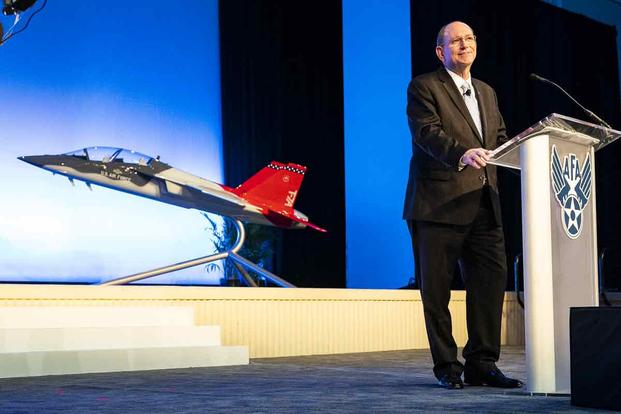The Air Force's new T-7A Red Hawk training jet was expected to be delivered to the service this year, but software issues and concerns connected to the ejection system have pushed the first deliveries into 2025. A full fleet now won't be available to airmen until 2027.
Andrew Hunter, the assistant secretary of the Air Force for acquisition, technology and logistics, told Military.com in an emailed statement that further tests are ongoing to "resolve issues with the escape system and move forward to deliver the training capability the Air Force requires."
An Air Force spokesperson told Military.com that "estimated first delivery of production aircraft will occur in December 2025." Hunter added that the full fleet would be available by 2027, a significant departure from the original timeline.
"By extension, this will shift the T-7A program's initial operational capability (IOC) into the Spring of 2027," Hunter said in a statement, referring to the aircraft being ready for routine use for training.
Boeing was awarded a $9 billion contract to build the T-7 in 2018, with original plans to have the first planes delivered by 2023.
But the T-7A's significant delay means the Air Force must continue to rely on the aging T-38C Talon, a training jet that has been in its fleet since the 1960s and has seen a slew of recent accidents and issues.
Between 1960 and 2021, there were 211 Class-A mishaps -- the term used by the military to describe the deadliest or costliest crashes -- with the T-38, according to the latest available Air Force Safety Center data. There have been a total of 86 pilot deaths and 149 fatalities of co-pilots and people on the ground in the Talon's 63-year history.
The T-38C was involved in several mishaps last year at Columbus Air Force Base in Mississippi.
On Nov. 18, one plane's landing gear failed, forcing it to skid on its belly across a runway before coming to rest. There were no injuries.
Less than two weeks before, on Nov. 7, an instructor pilot had to eject from his jet when it was "rendered inoperable and unrecoverable upon initial takeoff," Col. Jeremy Bergin, Columbus Air Force Base vice wing commander, told reporters.
In that incident, two T-38Cs took off, each with one person, an instructor, aboard. They were flying in formation when one of the jets experienced a malfunction. The jet crashed at a private property about 30 minutes south of the base. The instructor was taken to a nearby hospital, and there were no fatalities, according to a press release.
On Feb. 19, 2021, two pilots in a T-38 from Columbus AFB died during a training mission outside of Montgomery, Alabama, as the jet was making its way to Florida. Killed in the crash were Scot Ames Jr., an instructor pilot with the 50th Flying Training Squadron, and Renshi Uesaki, a student pilot who was a member of the Japan Air Self-Defense Force.
In May 2018, two pilots ejected from their T-38 near Columbus AFB, and the plane crashed in a remote part of northeast Mississippi. In August that same year, the base halted flight operations for 24 hours after a T-38 ejection seat inadvertently fired while the plane was undergoing inspection.
An updated ejection system is one of the highlighted features on the new T-7A; it is planned to be more flexible for pilots of varying heights and weights than that on the Talon.
The service told Military.com in December that "technical challenges the Air Force has identified relate to flight control software and the escape system," adding that "the ejection seat wasn't performing adequately and could have caused injury."
Concerns with the new system raised last year have already been addressed and will be examined during testing.
"The minor changes to seat logic have already reduced system risk and increased pilot safety," an Air Force spokesperson said. "Additionally, the USAF and Boeing are studying the ejection seat performance throughout 2023 to identify additional enhancements, and Boeing will use the results of testing to inform changes needed to qualify the seat as safe for production."
So far, Boeing has built a total of five production T-7 aircraft, according to an Air Force spokesperson. Flight testing is scheduled to start at Edwards Air Force Base in California this September.
-- Thomas Novelly can be reached at thomas.novelly@military.com. Follow him on Twitter @TomNovelly.
Related: New Air Force Trainer Jet Facing Delays as Mishaps with Old Training Aircraft Mount










